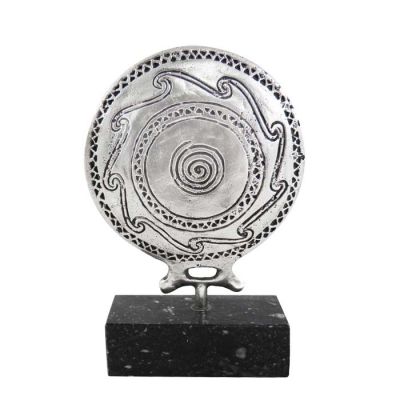Pottery was widely used in the Early Cycladic civilization and nowadays is one of the richest sources for study of the life and art of the ancient Cycladic islanders. Among the clay vessels that were found, mostly in Syros, which are dated to the Early Cycladic II period (2800-2300 B.C.), the frying-pan vessels stood out. Inspired by their shape and their depictions, we created a silver-plated relief. The relief is made of brass, coated in silver solution 999° and placed on a marble base. It can be used as a paperweight for your office, as well.
Dimensions: 8,5cm x 12cm x 3,5cm
All prices include VAT.
Among the clay vessels of the cycladic art, the frying-pan vessels stand out, which owe their name to the fact that they resemble a frying pan. They date back from the Early Cycladic II period (2800-2300 BC) and the purpose of these vessels with a forked handle is uncertain. On their undecorated side there is an upright rim. The other side is covered with incised and impressed motifs. A pubic triangle appears near the handle. The motifs decorating them are inspired by the world of the sea, such as spirals, which recall waves, the sun, stars, and the starfish.
It is not known exactly how the frying-pan vessels were used. It has been suggested that they functioned as mirrors, if they were filled with water, or drums, if they were originally covered with skin, and even as primitive navigation instrumentsor as moulds for making salt cakes, or even that their decoration was of some symbolic religious significance related to the sun, the sea and female fertility.
Since they were primarily grave gifts, a ceremonial or religious use cannot be ruled out. It may be that they were destined to hold objects used for the beautification of the dead or that they were used as containers for offering fruits to the dead or as drums in funerary ceremonies. The motifs possibly had a religious character, but it remains a fact that frying-pan vessels are sometimes found in settlements as well as graves, and that they are sometimes undecorated. It is, therefore, clear that they were used in everyday life too.
Frying-pan vessels are kept in the National Archaeological Museum of Athens.
No posts found






